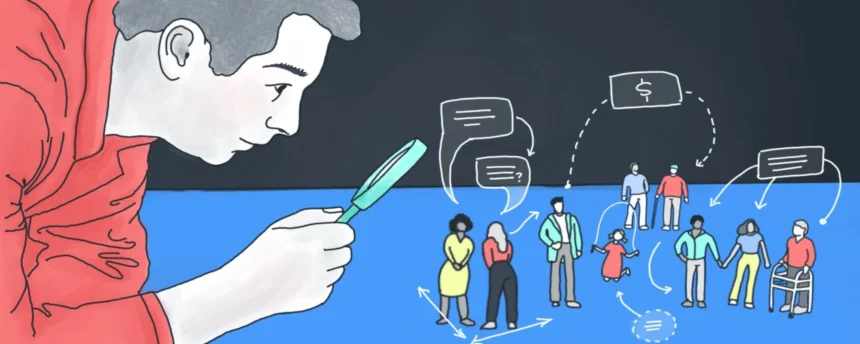“Fashion’s Never Finished GIF Social Experiment” has recently gained traction online, drawing curious audiences into a reflective conversation about how fashion evolves, how we consume it, and what it means in the a digital age. This article explores how this GIF-based project works, its themes, its impact, and how it can reshape fashion storytelling in the internet era.
What Is the “Fashion’s Never Finished GIF Social Experiment”? Origins & Purpose
Fashion’s Never Finished isn’t a traditional fashion campaign or a clothing line — it’s a conceptual digital experiment. At its core, the project uses looping GIFs to illustrate how fashion is perpetual: always shifting, remixed, referenced, and reinterpreted.
The name itself — “Fashion’s Never Finished” — signals that there is no final state in style; fashion is not static. The use of GIFs was intentional: the format loops forever, visually embodying the idea that fashion is cyclical and never truly “done.”
This is described as a “social experiment” because the creators released these GIFs into public social platforms (Instagram, Tumblr, Twitter etc.), inviting the audience not just to observe, but to react, comment, remix, and contribute. It is participatory rather than top-down.
How the GIFs Are Constructed: Visual Technique & Symbolism
The power of this experiment lies in how the images are put together. The GIFs are not simple repeats — they are layered, blended, transitional works in which clothing from one era melts or shifts into garments from another era.
For example, a flapper dress from the 1920s might gradually morph into a 1990s slip dress, then into a modern runway silhouette. These transitions make visible the genealogy of style — how designers borrow, adapt, and reinterpret.
These visual mashups are sometimes called palimpsests in digital form: earlier styles are not erased but overlaid, reframed, and transformed. The result is a digital tapestry of fashion history.
Because the GIF loops infinitely, viewers have the freedom to watch transitions, notice details in the morphing frames, and question the nature of continuity in style. The repeating motion itself becomes a metaphor: fashion is a cycle rather than a linear path.
Central Themes & Interpretations
This GIF experiment is rich with themes. Below are some of the most salient ones observed by commentators and creators.
1. Fashion as Cyclical & Remix Culture
One clear message is that trends don’t vanish—they recycle. Styles that seemed novel often echo past decades. But the project doesn’t simply show copycat fashion; it highlights adaptation — how context, materials, and cultural values shape each reincarnation
2. Democratization of Fashion Narrative
By releasing the GIFs publicly and allowing feedback, the project shifts the narrative from designers dictating trends to a collective conversation. The audience becomes co-authors of style history.
3. Memory, Nostalgia & Identity
When you see a garment morphing into something familiar from your youth, it triggers memories: music, social context, identity. The experiment leverages this emotional dimension of fashion.
4. Critique of Fast Fashion
Implicitly, the looping experiment critiques the disposable nature of fast fashion. If fashion is never finished, constant turnover is excessive — the experiment encourages looking backward, not always forward
5. Digital Aesthetics & Visual Literacy
Using a digital medium (GIF) to talk about a physical medium (clothing) invites reflection on how we see style in the internet age: through loops, edits, filters. It asks: what does fashion mean when seen through a screen?
The Social Reaction & Participatory Dimension
A key aspect of this project is how people responded and participated — turning passive viewing into conversation and co-creation.
Audience Engagement & Dialogue
Many viewers comment on the eras they recognize, debating whether a particular transition was accurate, or whether a particular cut should morph into a certain modern style. These dialogues become mini fashion critiques.
Others share personal memories: “I remember wearing that in high school,” or “That silhouette reminds me of my grandmother’s dress.” The GIF triggers storytelling.
User Submissions & Expansion
Some versions of the experiment encourage users to submit their own vintage photos or suggest decade pairings, thereby expanding the project. The boundary between creator and audience becomes porous.
Remixes & Derivative Works
Fans produce derivative GIFs or remixes of transitions, effectively expanding the experiment’s visual vocabulary. Some experiment with more radical transformations (e.g. crossing cultures, mixing streetwear & historical dress). The GIFs become a canvas for remix culture.
The experiment thus becomes less a fixed project and more a living conversation about style, technology, and memory.
Cultural & Industry Impact: Why It Matters
Though relatively recent, the Fashion’s Never Finished GIF Social Experiment is more than aesthetic fun — it signals shifts in how fashion discourse is produced and consumed.
Educational & Historical Value
The GIFs act as visual primers in fashion history, accessible to those who might not read scholarly texts. The morphing transitions teach visual literacy in style.
Brand & Marketing Potential
Brands observing this experiment may be inspired to adopt digital storytelling methods: GIF campaigns, looping animations, interactive visuals—not just static lookbooks. It suggests a new paradigm in fashion marketing.
Sustainability & Ethical Reflection
By foregrounding that style is iterative — not disposable — the experiment encourages more thoughtful consumption. It nudges viewers to see clothes as part of a long continuum rather than seasonal disposables.
Blurring Art, Fashion & Digital Media
The experiment exists at the intersection: fashion as art, digital forms as medium, social media as gallery. It suggests that future meaningful fashion projects might live more in the digital realm than physical catwalks.
Shaping Future Experimentation
This project may inspire more experiments using AR, VR, GIFs, looping videos, NFTs, or interactive filters to reflect on fashion. The idea that fashion is never finished is a fertile engine for new media projects.
How to Explore, Contribute to, or Start Similar Experiments
If this experiment fascinates you, here’s how you can dive in — either as participant, critic, or creator.
1. Find the GIFs
Search social media platforms (Instagram, Tumblr, Twitter/X) for “Fashion’s Never Finished GIF” or tags like #FashionsNeverFinished. The original creators may post via their handles; remixes and shares propagate them.
2. Analyze & Comment
Watch the loops carefully. Pause on frame transitions. Ask yourself:
- What periods/styles are being connected?
- Do the transitions seem natural or forced?
- What emotional associations each style conjures?
Share observations in comments, threads, or blogs. Your reflection adds value.
3. Submit Visuals or Suggestions
If the project invites viewer contributions, submit vintage photos, style comparisons, or decade mashups. Volunteer suggestions for transitions you’d like to see.
4. Create Your Own Looping GIFs
With basic tools (Photoshop, After Effects, online GIF makers), you can create your own GIF experiments: pick two epochs, morph garments, loop transitions. Use them to explore your personal style lineage. Share with tags or communities.
5. Extend into AR / Filters / Video
Take the idea further: build Instagram filters that blend style eras, or short looping videos that morph outfits in real time. The principle of perpetual fashion can live in new interactive formats.
6. Document & Write About It
Write blog posts, analyses, or essays about what the experiment reveals. Use the keyword “Fashion’s Never Finished GIF Social Experiment” in your title, headings, and meta tags. Your content may become a reference point for future searchers.
Conclusion: Why This Experiment Resonates
The Fashion’s Never Finished GIF Social Experiment functions as a bridge between style and theory, memory and innovation, consumer and creator. In just a few looping seconds, it provokes reflection: What do we expect from fashion? Is it ever truly new? How do we perceive continuity in change?
By adopting a digital form native to the internet — the GIF — it meets us in the language we consume: quick, visual, looped, remixable. It transforms fashion from commodity to conversation, signaling that in an age of fast cycles, perhaps we need experiments that slow us down—in loop, one frame at a time.








